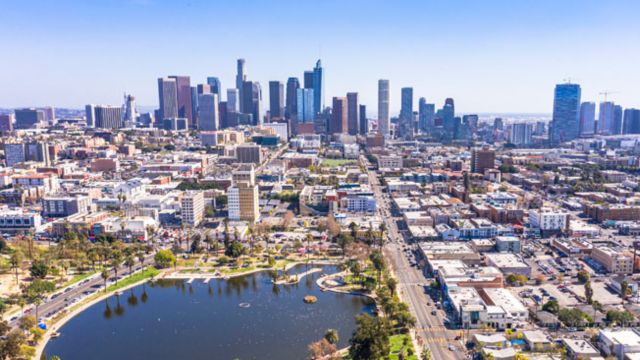California is a state known for its stark contrasts, encompassing stunning landscapes, rich cultural diversity, and thriving industries. Nevertheless, not every corner of the Golden State offers a safe and tranquil environment. Some cities grapple with elevated crime rates and violence, rendering them less secure for both residents and tourists. In this blog, we will delve into the most perilous city in California, as indicated by the latest FBI crime statistics: Emeryville.
What makes Emeryville stand out in terms of its safety concerns?
Emeryville, situated in Alameda County, is a relatively small city with a population of approximately 12,000 residents. Nestled along the eastern shoreline of the San Francisco Bay, it hosts several prominent corporations, including Pixar, Peet’s Coffee, and Clif Bar. Emeryville also boasts a vibrant arts and culture scene, with numerous galleries, theaters, and festivals.
However, beneath the facade of prosperity and creativity lies a troubling reality: Emeryville bears the dubious distinction of having the highest violent crime rate in California, and one of the highest in the nation. According to the FBI’s data, Emeryville recorded a staggering 6,284 violent crimes per 100,000 residents in 2021. This translates to one in every 16 people in Emeryville falling victim to violent crimes such as murder, rape, robbery, or assault. To provide context, the average violent crime rate in California stood at 495 per 100,000 residents, with the national average at 382 per 100,000 residents.
Emeryville also grappled with a remarkably high property crime rate in 2021, registering 14,835 property crimes per 100,000 residents—more than three times the state average of 4,165 per 100,000 residents. Property crimes encompass offenses like burglary, theft, arson, and vandalism, with larceny-theft constituting the most prevalent form, accounting for 87% of all property crimes in Emeryville.
What are the underlying factors and consequences of Emeryville’s crime predicament?
Understanding the factors contributing to Emeryville’s high crime rates is far from straightforward. Nevertheless, several potential elements play a role:
- Poverty and Inequality: Emeryville contends with a substantial poverty rate, standing at 19.5%, significantly surpassing the state average of 11.8%. High poverty rates can induce desperation and frustration, leading some individuals to turn to criminal activities as a means of survival or coping. Moreover, Emeryville grapples with a stark wealth gap, with some residents residing in luxury condominiums while others inhabit dilapidated apartments or seek refuge in homeless shelters. This economic disparity can breed resentment and tension among various social groups, fostering feelings of exclusion and exploitation.
- Drugs and Gangs: Emeryville confronts a serious drug epidemic, with numerous residents struggling with addiction to substances such as heroin, methamphetamine, cocaine, or prescription opioids. Drug abuse can impair judgment and escalate aggression among users, potentially leading to criminal acts to sustain their habits or settle disputes with dealers and rivals. Additionally, the city is home to several active gangs, including the Border Brothers, Norteños, and Sureños, involved in drug trafficking, extortion, robbery, and inter-gang violence that can spill over to affect innocent bystanders.
- Limited Police Resources and Community Trust: Emeryville’s police force is small, understaffed, and underfunded, comprising only 38 sworn officers who must contend with more than 10,000 calls for service annually. This resource scarcity often leaves law enforcement overwhelmed and unable to effectively respond to incidents or prevent crimes. Furthermore, some residents harbor distrust or reluctance to cooperate with the police, stemming from past instances of misconduct or discrimination. This lack of cooperation hampers crime-solving efforts and inhibits the establishment of positive police-community relations.
- Geographical Factors: Emeryville’s location along the bay renders it an appealing target for criminals, thanks to easy access from various directions facilitated by a network of major highways (I-80, I-580, I-880) and bridges (Bay Bridge, San Mateo Bridge) linking it to neighboring cities. The city’s public transportation system (BART, AC Transit) further enables swift movement in and out of Emeryville, affording criminals convenience in committing offenses before fleeing to other areas.
The repercussions of Emeryville’s elevated crime rate extend to its residents and visitors alike, resulting in:
- Fear and Anxiety: A significant portion of Emeryville’s population lives in constant fear of becoming victims of crime or witnessing violent incidents. This fear may discourage nighttime outings or visits to specific areas and establishments deemed unsafe. Moreover, it can manifest as stress or trauma, negatively impacting both mental and physical well-being.
- Loss and Damage: Many Emeryville residents experience profound losses, whether in terms of lives, loved ones, property, or their sense of security, due to criminal activities. Coping with the emotional, financial, and legal burdens of crime recovery or seeking justice can be overwhelming. Additionally, those affected may face social stigma or discrimination tied to their association with a city known for its safety challenges.
- Decline and Deterioration: The city’s high crime rate can deter potential investments and visitors, leading to revenue losses, job scarcity, and a diminished quality of life for both residents and the city itself. Infrastructure and environmental deterioration may also ensue.
What measures can be taken to enhance Emeryville’s safety?
Addressing Emeryville’s crime issue is a multifaceted endeavor. However, several potential steps can be considered to bolster safety within the city:
- Augmenting Police Resources and Fostering Community Trust: Emeryville would benefit from bolstering its police force with well-trained, adequately equipped, and well-supported officers. Ensuring that law enforcement has the necessary resources to respond to calls, patrol neighborhoods, conduct thorough investigations, and proactively prevent crimes is imperative. Building trust and cooperation between the police and the community is equally essential. Transparency, accountability, respect, and fairness must underpin police-community interactions, allowing both sides to collaborate in identifying and addressing the root causes of crime and violence in Emeryville.
- Mitigating Poverty and Inequality: Emeryville should prioritize creating opportunities and support systems for its disadvantaged and marginalized residents. This entails expanding affordable housing options, enhancing access to quality education, healthcare, social services, and vocational training. Efforts to reduce income disparities should also be pursued, encompassing fair wages, equitable taxation, and comprehensive worker benefits. Inclusivity, diversity, and solidarity should be promoted throughout the city.
- Combating Drugs and Gang Activity: Addressing Emeryville’s drug problem necessitates the implementation of prevention, treatment, and recovery programs for individuals battling addiction. The city must also intensify efforts to curb drug trafficking and manufacturing within its borders, clamping down on dealers and suppliers. Similarly, gangs operating in Emeryville should be actively targeted, focusing on dismantling their leadership, membership, assets, and criminal operations. Providing viable alternatives and incentives for at-risk youth is essential in preventing their involvement in gangs or drug-related activities.
- Leveraging Location and Accessibility: Emeryville should harness its strategic location and accessibility to its advantage. Collaborative efforts with neighboring cities to share information, resources, and crime-fighting strategies can be instrumental in reducing criminal activity. Improvements in public transportation systems, enhancing safety, reliability, and efficiency, can facilitate the movement of residents and visitors. The city should also invest in pedestrian and bicycle-friendly infrastructure, including sidewalks, bike lanes, crosswalks, lighting, and signage to improve overall urban mobility.
In Conclusion
Emeryville, despite its inherent strengths and potential, grapples with significant challenges, primarily driven by its high crime rates. It bears the unenviable title of California’s most dangerous city, owing to its elevated rates of both violent and property crime. However, it is crucial to recognize that the situation is not insurmountable. Emeryville possesses the means to enhance its safety and security by addressing the root causes and consequences of its crime problem. By taking decisive action, Emeryville can evolve into a more welcoming and secure place for both its residents and visitors.

